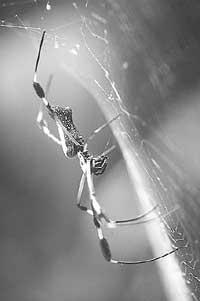Hardness of spider nets

According to scientists, the silk used by the spider Nephila clavipes to make nets is harder and more elastic than the cetaceans devour. It is thinner than man's hair, but harder than steel and more elastic than any polymer fiber. In view of this, scientists begin to analyze the sequence of genes that encode silk to discover the molecular structure of the spider web and how to wind the net. Thus, some of the products currently manufactured with synthetic fibres (flame retardant clothing, anti-whales, sports rackets, various aircraft components, etc.) could be made with this new material.
Spider silk is made up of long protein molecules that form crystalline regions in a network without structures. Amorphous regions without structures are easily extended, so silk is elastic. On the other hand, the crystalline structures are kept in propellers and folds, which confers hardness to the spider web. Synthetic fibres also have glazed structures, but in order to obtain them it is necessary that the polymer chains withstand high temperatures and pressures, in addition to using organic solvents of high acidity.
According to scientists Vollrath and Knight of Oxford University, spiders use a crystalline liquid lube to start winding the net. About 50% of this lubricant consists of silk proteins. In the industry, on the contrary, it is impossible to produce solutions so concentrated that they are too viscous.
Buletina
Bidali zure helbide elektronikoa eta jaso asteroko buletina zure sarrera-ontzian










